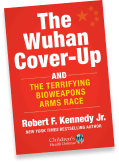No More Research on Cellphone Radiation and Human Health, Government Says
The National Toxicology Program said it no longer plans to study the effects of cellphone radiation on human health, citing technical challenges and lack of resources — even though its own $30 million study found evidence of cancer and DNA damage.
Miss a day, miss a lot. Subscribe to The Defender's Top News of the Day. It's free.
The National Toxicology Program (NTP) has no plans to further study the effects of cellphone radiofrequency radiation (RFR) on human health — even though the program’s own $30 million study that took about 10 years to complete in 2018 reported evidence of cancer and DNA damage.
The NTP said in an updated January 2024 fact sheet that it was abandoning further investigation because “the research was technically challenging and more resource-intensive than expected.”
For decades, the NTP has been the premier governmental testing program for pharmaceuticals, chemicals and radiation, according to Devra Davis, Ph.D., MPH, a toxicologist and epidemiologist who served on the board of scientific counselors for the NTP when it was launched in the 1980s.
Commenting on the news, Davis said, “It is the ultimate arrogance and folly to stop doing research on this major growing environmental pollutant, precisely when we have ample evidence of harm.”
Davis has authored more than 200 peer-reviewed publications in books and journals, ranging from The Lancet to the Journal of the American Medical Association.
In February 2023, she and her colleagues published a review of more than 200 studies that linked wireless radiation to negative biological effects including oxidative stress and DNA damage, cardiomyopathy, carcinogenicity, sperm damage, memory damage and other neurological effects.
They will soon publish a “major new article” in Environment: Science and Policy for Sustainable Development journal about “new science” on RFR and call for precaution, she said.
Davis — who also is the founding director of the Board on Environmental Studies and Toxicology of the U.S. National Research Council at the National Academy of Sciences and the founder and president of Environmental Health Trust — called out the U.S. government for failing to ensure that wireless radiation is safe:
“The government’s decision to stop funding research on cellphone radiation is consistent with the Chinese proverb ‘If you don’t want to know, don’t ask.’
“The US government has a variation of that in the policy of, ‘don’t ask, don’t tell.’ If you don’t want to know whether cell tower radiation is having a biological impact, stop doing the research!”
Miriam Eckenfels-Garcia, director of Children’s Health Defense’s (CHD) Electromagnetic Radiation (EMR) and Wireless program, told The Defender:
“Discontinuing government-funded research because it is ‘technically challenging’ and ‘resource-intensive’ is not what we expect from government agencies that are supposed to protect people from the harms of big industry.
“This research is important so that people can make informed decisions when it comes to the use of technology.”
W. Scott McCollough, lead litigator for CHD’s EMR cases, agreed. “I am concerned that the absence of evidence will be contorted into a claim of evidence of absence.”
As of early last year, the NTP was still conducting RFR research. A February 2023 fact sheet said scientists had “overcome several technical issues” and developed a better system for exposing animals to RFR for their studies.
NTP said researchers were “now making progress” on four research goals:
- Determining the impact of RFR exposure on behavior and stress.
- Conducting physiological monitoring, including evaluation of heart rate.
- Investigating whether RFR induces heating.
- Further evaluating whether RFR exposure causes DNA damage.
In its January 2024 fact sheet, the NTP reported the researchers had “tested the new exposure system … in vivo rodent studies” and that their research was “complete.”
The NTP did not say whether the researchers had achieved those four research goals and, if so, what the results were. It did, however, make clear that its previous studies — which used 2G and 3G cellphones — “do not apply” to 4G or 5G technologies.
The Defender reached out to NTP’s press office for clarification about why the new fact sheet appears to contradict the NTP website (updated Jan. 8, 2024) on cellphone radiation research which says NTP still has “current research efforts,” however NTP did not respond by our publication deadline.
The NTP’s discontinuation of its RFR research suggests the U.S. government has no intention of studying the possible biological effects of 5G.
Meanwhile, researchers such as Davis continue to say there is reason for concern. Davis pointed out that infertility clinics ask men about their wireless devices and cellphone habits:
“They tell them to take these phones off their bodies and out of their pockets because there is evidence … where the greater the exposure, the lower the sperm count, and the poorer the sperm quality.
“This has been repeatedly shown in studies with human sperm done under controlled conditions, as well as cross-sectional studies.”
“In fact,” she added, “whether the government stops doing the research or not, there is a massive study underway because we have billions of people being exposed to ever-increasing levels of wireless radiation throughout the world. Millions of American children are exposed every day in classrooms.”
“The only problem is there is no control group anymore, which will make it difficult, but not impossible, to discern the impacts of wireless radiation,” Davis said.
What NTP’s 2018 study found
As The Defender previously reported, NTP researchers in 2018 concluded there was “clear evidence” that male rats exposed to high levels of RF similar to those emitted by 2G and 3G cellphones developed cancerous heart tumors, and “some evidence” of tumors in the brain and adrenal gland of exposed male rats.
Davis said NTP’s conclusions were consistent with and corroborated dozens of other studies. “It wasn’t like it [the NTP study] was a one-off study,” she said.
Once the word got out that the findings of the NTP study were positive — meaning the government researchers had found an association between cellphone radiation and the growth of cancerous tumors — the telecommunication industry “started its tactics” to suppress the findings, Davis said.
Davis has been researching those tactics for more than a decade. She is the author of “Disconnect: The Truth About Cell Phone Radiation, What the Industry Is Doing to Hide It, and How to Protect Your Family.”
Instead of the NTP study report being released in 2016, when it was first ready, she said, the telecom industry exerted pressure to subject the study’s conclusions to an unprecedented level of scrutiny.
“When the first drafts began to circulate internally, it was elevated for a peer review unlike any that has ever been conducted in the history of the entire program — and I can say that with great certainty. No other compound or substance [studied by the NTP] has ever been subject to this level of peer review,” Davis said.
A panel of external scientific experts convened for a three-day review of the study and its conclusions in March 2018.
However, rather than downplaying the study’s conclusions, the experts concluded that the scientific evidence in the study was so strong they recommended the NTP reclassify some of its conclusions from “some evidence” to “clear evidence” of carcinogenic activity.
To date, more than 250 scientists — who together have published more than 2,000 papers and letters on the biologic and health effects of non-ionizing electromagnetic fields (EMFs) produced by wireless devices, including cellphones — signed the International EMF Scientist Appeal, which calls for health warnings and stronger exposure limits.
Sign up for free news and updates from Children’s Health Defense. CHD focuses on legal strategies to defend the health of our children and obtain justice for those injured. We can't do it without your support.






